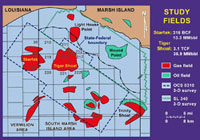 |
|
Click
on graphic for details.
|
| |
|
PUBLICATIONS
|
| T. Hentz
and J. Zeng, 2003, High-Frequency Miocene Sequence Stratigraphy,
Offshore Louisiana: Cycle Framewodk and Influence on Production
Distribution in a Mature Shelf Province: AAPG Bulletin [PDF] |
| |
| M. De
Angelo and L. Wood, 2001, 3-D Seismic Detection of Undrilled
Prospective Areas in a Mature Province, South Marsh Island,
Gulf of Mexico: The Leading Edge [PDF] |
|
|
|
|
Targeting
Reserve Growth Opportunities in the Northern Gulf of Mexico Basin:
Transferring Secondary Gas Recovery Technology to the Offshore Environment
|
| Lesli
J. Wood, principal investigator; Tucker
F. Hentz, Hongliu Zeng,
Michael V. DeAngelo,
Shirley P. Dutton, Mark
H. Holtz, and Eugene M. Kim |
|
The Offshore
Secondary Gas Recovery (Offshore SGR) project was completed in 2002.
Detailed architectural frameworks have been developed to model reservoir
flow patterns and target bypassed zones. Stratigraphic and saddle-perched
structural traps have been defined to extend traditional field boundaries
and open up new targets. Stratal slicing (or proportional slicing)
was used to create more coherent amplitude maps for initial identification
of several low-sinuosity, high-amplitude features throughout the
data volume. One of two prospect ideas developed by the team and
successfully drilled by industry partner Texaco contained probable
recoverable reserves of 5.7 Bcf.
Offshore SGR,
a joint venture between the Bureau and the U.S. Department of Energy
begun in 1998, was charged with identifying new technologies and
processes to aid in the recovery of hydrocarbons from known fields.
The completed project extended investigations into the northern,
offshore Gulf of Mexico (GOM) Federal Outer Continental Shelf, where
nearly 10,000 gas- and oil-producing reservoirs are found in more
than 1,000 fields. The research focused on the Miocene-age reservoirs
that comprise 42 percent of original proven reserves in the GOM.
Because of the stratigraphic and structural complexity of the Tertiary-age
section in this region, there is potential for significant gas resources
to have been bypassed even in densely drilled fields.
|
| |
| For
more information, please contact Lesli Wood, principal investigator.
Telephone 512-471-0328; e-mail lesli.wood@beg.utexas.edu. |
|
February
2003
|
|

